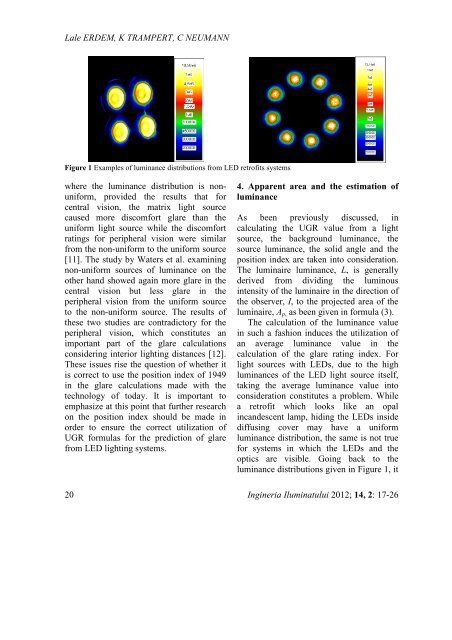Untitled - Journal of Lighting Engineering
Untitled - Journal of Lighting Engineering
Untitled - Journal of Lighting Engineering
Create successful ePaper yourself
Turn your PDF publications into a flip-book with our unique Google optimized e-Paper software.
Lale ERDEM, K TRAMPERT, C NEUMANN<br />
Figure 1 Examples <strong>of</strong> luminance distributions from LED retr<strong>of</strong>its systems<br />
where the luminance distribution is nonuniform,<br />
provided the results that for<br />
central vision, the matrix light source<br />
caused more discomfort glare than the<br />
uniform light source while the discomfort<br />
ratings for peripheral vision were similar<br />
from the non-uniform to the uniform source<br />
[11]. The study by Waters et al. examining<br />
non-uniform sources <strong>of</strong> luminance on the<br />
other hand showed again more glare in the<br />
central vision but less glare in the<br />
peripheral vision from the uniform source<br />
to the non-uniform source. The results <strong>of</strong><br />
these two studies are contradictory for the<br />
peripheral vision, which constitutes an<br />
important part <strong>of</strong> the glare calculations<br />
considering interior lighting distances [12].<br />
These issues rise the question <strong>of</strong> whether it<br />
is correct to use the position index <strong>of</strong> 1949<br />
in the glare calculations made with the<br />
technology <strong>of</strong> today. It is important to<br />
emphasize at this point that further research<br />
on the position index should be made in<br />
order to ensure the correct utilization <strong>of</strong><br />
UGR formulas for the prediction <strong>of</strong> glare<br />
from LED lighting systems.<br />
4. Apparent area and the estimation <strong>of</strong><br />
luminance<br />
As been previously discussed, in<br />
calculating the UGR value from a light<br />
source, the background luminance, the<br />
source luminance, the solid angle and the<br />
position index are taken into consideration.<br />
The luminaire luminance, L, is generally<br />
derived from dividing the luminous<br />
intensity <strong>of</strong> the luminaire in the direction <strong>of</strong><br />
the observer, I, to the projected area <strong>of</strong> the<br />
luminaire, Ap, as been given in formula (3).<br />
The calculation <strong>of</strong> the luminance value<br />
in such a fashion induces the utilization <strong>of</strong><br />
an average luminance value in the<br />
calculation <strong>of</strong> the glare rating index. For<br />
light sources with LEDs, due to the high<br />
luminances <strong>of</strong> the LED light source itself,<br />
taking the average luminance value into<br />
consideration constitutes a problem. While<br />
a retr<strong>of</strong>it which looks like an opal<br />
incandescent lamp, hiding the LEDs inside<br />
diffusing cover may have a uniform<br />
luminance distribution, the same is not true<br />
for systems in which the LEDs and the<br />
optics are visible. Going back to the<br />
luminance distributions given in Figure 1, it<br />
20 Ingineria Iluminatului 2012; 14, 2: 17-26
















